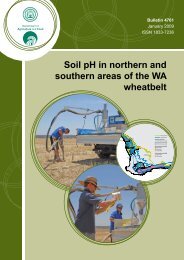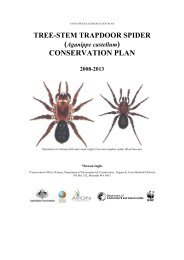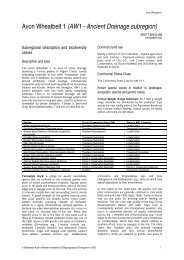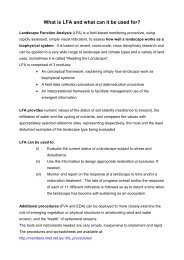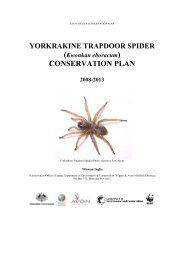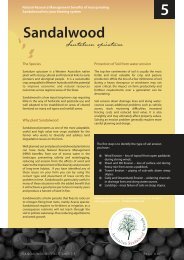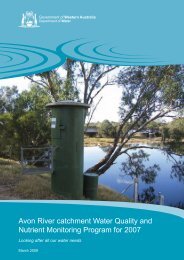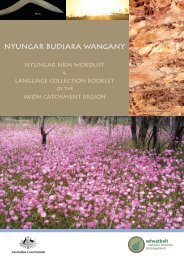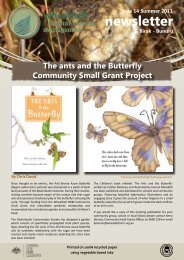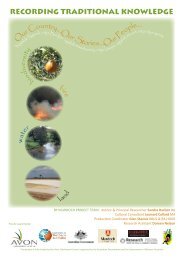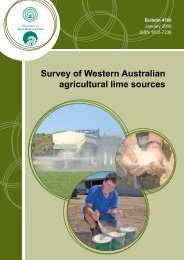Kokerbin Nature Reserve Desktop Fauna ... - Wheatbelt NRM
Kokerbin Nature Reserve Desktop Fauna ... - Wheatbelt NRM
Kokerbin Nature Reserve Desktop Fauna ... - Wheatbelt NRM
You also want an ePaper? Increase the reach of your titles
YUMPU automatically turns print PDFs into web optimized ePapers that Google loves.
<strong>Kokerbin</strong> <strong>Nature</strong> <strong>Reserve</strong><br />
<strong>Desktop</strong> <strong>Fauna</strong> Assessment<br />
5.2.4 Invertebrates<br />
Shield-backed Trapdoor Spider (Idiosoma nigrum) SCHEDULE 1<br />
The Shield-back Trapdoor Spider (Idiosoma nigrum) is listed under Schedule 1 of the<br />
WA Wildlife Conservation Act 1950. It is confined to the northern <strong>Wheatbelt</strong> and<br />
adjacent parts of the Murchison, where it occurs in scattered populations often<br />
associated with rocky slopes. A number of populations occur on the slopes of<br />
ironstone hills, including at Weld Range, and at Karara, Mungada, and Wongan Hills<br />
(J. Turpin, pers. obs.). Other populations are associated with open York Gum<br />
(Eucalyptus loxophleba), Salmon Gum (E. salmonophloia), wheatbelt Wando (E.<br />
capillosa) woodland, with Jam (A. acuminata) forming a sparse understorey (Main,<br />
1987, 1991, 1992) and some burrows have also been found in granite soils (Main,<br />
1992). Idiosoma nigrum is generally found in microhabitats associated with low-lying<br />
woodlands or bush vegetation (Main 2003).<br />
The Shield-back Trapdoor Spider (Idiosoma nigrum) is one on the most arid-adapted<br />
mygalomorph spiders in Australia (Main 1982). This is due to a combination of<br />
morphological and behavioural attributes, such as a deep burrow which provides a<br />
narrow range of temperature and humidity beneath the surface, ‘twig-lining’ of the<br />
burrow rim to increase the prey foraging area and a sclerotised abdominal cuticle<br />
which reduces evaporative water loss and also plugs the burrow to stop the entry of<br />
predators (Main, 1982).<br />
The Shield-back Trapdoor Spider, like many Mygalomorph spiders, has a restricted<br />
distribution due to a limited capacity for dispersal and occurrence in discontinuous<br />
habitat. This species has no capability for aerial dispersal (a characteristic found in<br />
many Mygalomorph spiders) and as a result emergent spiderlings are restricted to the<br />
local area, generally establishing their burrows within several centimetres of the<br />
matriarch female, forming a family cluster. Gene flow is facilitated by male-biased<br />
dispersal (≤ 500 m; B. Y. Main, pers. comm.), as males only leave their burrows in<br />
search of females, while females spend their entire life in the burrow and its proximity<br />
(Main, 1982, 2003).<br />
Idiosoma nigrum (like many mygalomorph spiders) is an ambush predator and<br />
constructs a burrow shelter underground (WAM, 2008). The distinctive burrow<br />
contains a trap door and a twig-lining radiating from the burrow entrance which acts<br />
as prey-detection device. This twig-line feeding strategy increases the spider's<br />
foraging area and its chances of catching food, especially when prey is scarce<br />
(DEWHA, 2009). Diet includes particularly ants, but also beetles, cockroaches, and<br />
millipedes and moths.<br />
Shield-backed Trapdoor Spider burrows can be up to 35mm in diameter and 32cm<br />
deep (DEWHA, 2009). The burrow is deep enough (up to 32 cm) to ensure that air in<br />
the lower burrow remains humid and relatively cool in summer. The spider's<br />
thickened cuticle helps reduces the rate of water loss from its body and provides a<br />
defence against predators – plugging the burrow and acting as a shield.<br />
42



